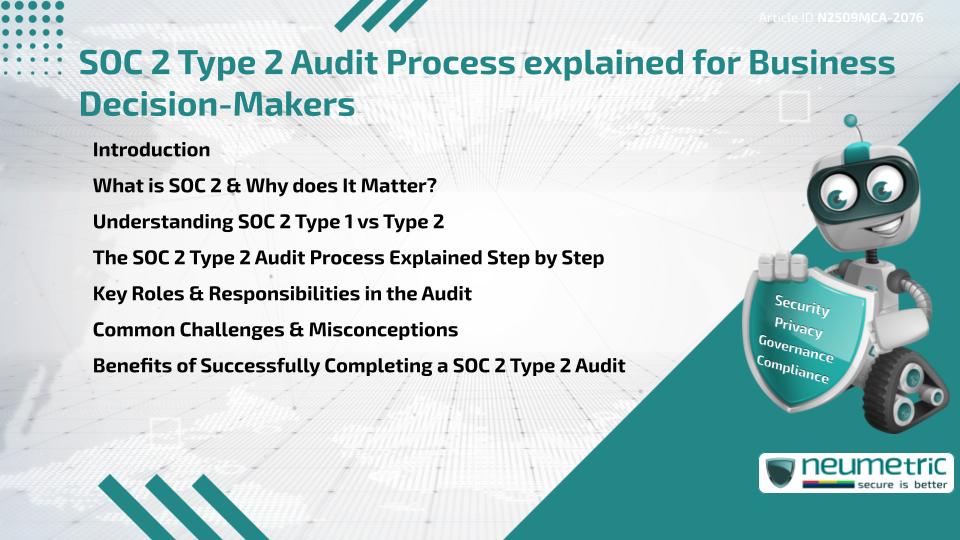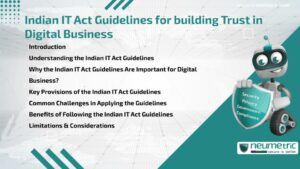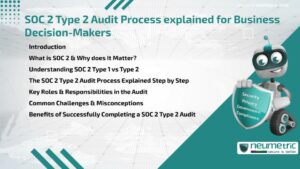Table of Contents
ToggleIntroduction
The SOC 2 Type 2 Audit process explained is essential for companies that handle sensitive Customer Data & wish to demonstrate Trust, Accountability & Compliance. This Audit evaluates not only whether Security Controls are designed properly but also whether they operate effectively over time. Business Decision-Makers should understand its requirements, benefits & challenges before committing resources. In this article, we cover what SOC 2 is, the difference between Type 1 & Type 2 audits, the step-by-step process, common challenges & the benefits of Compliance.
What is SOC 2 & Why does It Matter?
SOC 2 refers to Service Organisation Control 2, a Framework developed by the American Institute of Certified Public Accountants [AICPA]. It is based on five Trust Service Criteria: Security, Availability, Processing Integrity, Confidentiality & Privacy.
Unlike general Compliance frameworks, SOC 2 is tailored to service providers that store or process Customer Information. Passing this Audit reassures clients that an organisation has strong data safeguards. For businesses in industries like Cloud Computing, Fintech or Healthcare, SOC 2 can be the deciding factor in winning contracts.
Understanding SOC 2 Type 1 vs Type 2
Both SOC 2 Type 1 & Type 2 assess Internal Controls, but their scopes differ.
- Type 1 evaluates whether Security Controls are properly designed at a single point in time.
- Type 2 evaluates not only design but also operational effectiveness across a defined observation period, usually between six (6) to twelve (12) months.
This distinction is crucial. A Type 1 report provides assurance about readiness, while a Type 2 report demonstrates sustained Compliance. Clients often prefer Type 2 because it proves reliability over time.
The SOC 2 Type 2 Audit Process Explained Step by Step
The SOC 2 Type 2 Audit Process Explained can be divided into five (5) main phases:
- Scoping – Define which Trust Service Criteria apply to the business & what systems will be tested.
- Gap Analysis – Identify areas where current Controls do not meet SOC 2 requirements.
- Remediation – Implement changes to close Gaps, such as updating Policies or improving Monitoring Tools.
- Observation Period – Auditors track the company’s Controls over time, usually between six (6) to twelve (12) months.
- Audit Reporting – Auditors issue a final report that outlines findings, control effectiveness & any exceptions.
This process requires collaboration across departments, from IT & Legal to Operations & HR.
Key Roles & Responsibilities in the Audit
Several Stakeholders play critical roles in the Audit:
- Executives – Provide resources & align Compliance with strategic goals.
- IT Teams – Implement & Monitor technical safeguards.
- Compliance Officers – Coordinate policy development & ensure documentation accuracy.
- Auditors – Conduct independent assessments & prepare reports.
Decision-Makers should ensure all teams are aligned since fragmented efforts often delay certification.
Common Challenges & Misconceptions
Many Organisations face hurdles during their first SOC 2 Type 2 Audit. Common challenges include:
- Misunderstanding the difference between readiness & Compliance.
- Underestimating the time required for the observation period.
- Failing to maintain consistent documentation.
- Assuming technical controls alone guarantee success.
Another misconception is that passing the Audit is a one-time effort. In reality, SOC 2 requires Continuous Monitoring & yearly Audits.
Benefits of Successfully Completing a SOC 2 Type 2 Audit
The benefits extend far beyond Compliance:
- Market Differentiation – Demonstrates trustworthiness to potential Clients.
- Operational Discipline – Encourages better Security & documentation practices.
- Risk Management – Identifies Vulnerabilities before they cause harm.
- Client Retention – Builds confidence & long-term partnerships.
For Business Decision-Makers, SOC 2 Type 2 Compliance is more than an obligation; it is an investment in credibility.
Takeaways
- The SOC 2 Type 2 Audit Process Explained helps businesses safeguard data & prove operational effectiveness.
- Type 2 is more comprehensive than Type 1 because it evaluates Security Controls over time.
- Success depends on alignment across Executives, IT, Compliance & Auditors.
- Continuous Monitoring & Documentation are key to maintaining Compliance.
FAQ
What is included in the SOC 2 Type 2 Audit Report?
It includes a description of controls, the testing performed, results of the testing & any exceptions or weaknesses identified.
Who needs a SOC 2 Type 2 Audit?
Any service provider that manages sensitive Customer Data, such as SaaS companies, Cloud Providers or Payment Processors, may need it.
Is SOC 2 Type 2 a legal requirement?
No, it is not mandated by law, but many Clients require it as a condition for doing business.
What happens if we fail the Audit?
Failure does not mean shutdown. Instead, the report will note exceptions & businesses can remediate issues before the next Audit cycle.
Can Small Businesses complete a SOC 2 Type 2 Audit?
Yes, though smaller firms may find resource allocation challenging, they can still achieve Compliance with proper planning.
How often should SOC 2 Type 2 Audits be repeated?
They are typically conducted annually to ensure ongoing Compliance & Client assurance.
Need help for Security, Privacy, Governance & VAPT?
Neumetric provides organisations the necessary help to achieve their Cybersecurity, Compliance, Governance, Privacy, Certifications & Pentesting needs.
Organisations & Businesses, specifically those which provide SaaS & AI Solutions in the Fintech, BFSI & other regulated sectors, usually need a Cybersecurity Partner for meeting & maintaining the ongoing Security & Privacy needs & requirements of their Enterprise Clients & Privacy conscious Customers.
SOC 2, ISO 27001, ISO 42001, NIST, HIPAA, HECVAT, EU GDPR are some of the Frameworks that are served by Fusion – a SaaS, multimodular, multitenant, centralised, automated, Cybersecurity & Compliance Management system.
Neumetric also provides Expert Services for technical security which covers VAPT for Web Applications, APIs, iOS & Android Mobile Apps, Security Testing for AWS & other Cloud Environments & Cloud Infrastructure & other similar scopes.
Reach out to us by Email or filling out the Contact Form…





